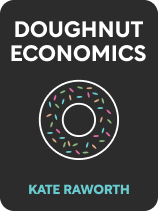

This article is an excerpt from the Shortform book guide to "Doughnut Economics" by Kate Raworth. Shortform has the world's best summaries and analyses of books you should be reading.
Like this article? Sign up for a free trial here .
Is constant economic growth sustainable? Is it time to end our obsession with economic growth and start transitioning to a post-growth economy?
Economic growth is not a remedy to humanity’s challenges. Despite growth, we still have a large amount of poverty, food insecurity, lack of opportunity, and other problems of deprivation. According to Kate Raworth, the author of Doughnut Economics, this is the time we start thinking about and planning for a no-growth future.
Here’s why economic growth does not equal prosperity and how we can start transitioning to a no-growth future.
The No-Growth Future
According to Raworth, the end of growth need not spell disaster. Indeed, our economy can continue to prosper and develop even if it isn’t growing. Raworth suggests some ideas for how we can build the post-growth economy:
1. Negative-interest currency: This is money that loses value over time and can’t be hoarded. Raworth argues that this incentivizes holders to invest in low- or no-growth enterprises that are socially or environmentally redeeming, since there’s no reason to hold onto money. This would tilt the scale toward long-term investment in the regenerative economy, where returns are lower and longer in outlook—but would fuel the social, cultural, environmental benefits we need.
(Shortform note: Having governments issue an entirely new currency that loses its value over time may be a needlessly complicated way to achieve the kind of long-term investments that Raworth champions. It’s not clear how much value the currency would lose and on what timescale, nor is it established who would make these decisions—would the depreciation schedule be established by statute or would central banks control this policy? Alternatively, the central bank could simply lower interest rates on the existing currency to negative levels. In fact, it’s not such a radical idea—countries including Switzerland, Sweden, Denmark, and Japan have already instituted negative interest rates.)
2. Tax reform: We need to crack down on tax havens and evasion, stop taxing labor and income streams, and start taxing accumulated wealth through progressive inheritance, land, and capital gains taxes. Once we do this, Raworth writes, we can use the tax code to reward employers for hiring and investing in people and workers’ skills.
(Shortform note: In Capital in the Twenty-First Century, Thomas Piketty proposes a global wealth tax as a potential check on soaring inequality. Such a tax would be progressive, with higher fortunes taxed at a higher marginal rate than smaller fortunes. Piketty argues that the purpose of the tax would not be to raise revenue. Instead, its purpose would be to stop the unchecked accumulation of wealth by the global hyper-wealthy, end the financial opacity that allows so much of the world’s wealth to exist in the shadows, and redistribute economic resources.)
3. Break the culture of consumerism: We define ourselves by our material lifestyle and what we buy. We are psychologically rooted to the idea of growth because it gives hope: that we’ll be richer, more comfortable, and have higher relative social standing. But, Raworth writes, this is hardly a universal trait of human cultures—it is a specific cultural by-product of hyper-capitalist societies. In fact, other cultures across the world and throughout history have been less acquisitive and more focused on sufficiency and satisfaction. We can even start to move away from the culture of rampant consumerism in small ways, such as by banning advertising in public places.
(Shortform note: Some commentators argue that the buying public is already moving away from the pattern of mass consumption that has been the engine of the past three centuries of economic growth. They write that consumers are becoming more environmentally conscious and are starting to think about the ecological impact of what they buy, how much they buy, and how long it lasts. This awareness of the production and consumption cycle on the part of buyers poses a genuine threat to the consumerism model—evidence of which can be seen in the notable decline of the retail sector.)

———End of Preview———
Like what you just read? Read the rest of the world's best book summary and analysis of Kate Raworth's "Doughnut Economics" at Shortform .
Here's what you'll find in our full Doughnut Economics summary :
- Why we need a top-to-bottom redesign of our global economic order
- Why long-term economic growth is unsustainable
- How inequality fuels a feedback loop that leads to more inequality






